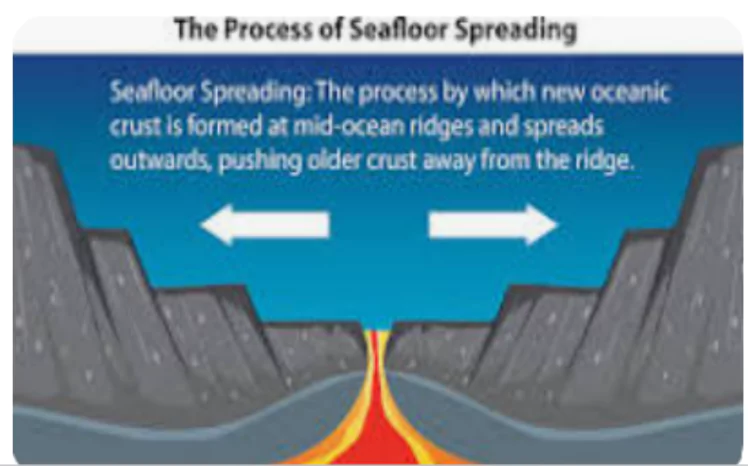Post-drift studies, including mapping of the ocean floor, revealed that oceanic rocks were notably younger than continental ones. Rocks adjacent to mid-oceanic ridge crests displayed striking similarities in composition and age. Arthur Holmes made a significant contribution in the 1930s with his convectional current theory, proposing that convection currents within the Earth’s mantle, driven by thermal variances from radioactive elements, play a crucial role. These findings set the stage for the emergence of the sea floor spreading theory.
Evidence for Sea-Floor Spreading
- Sea Floor Spreading: It is the process where new oceanic crust is formed at mid-ocean ridges and destroyed at deep-sea trenches.
- The mapping of the ocean floor and paleomagnetic studies of rocks from oceanic regions revealed the following facts:
- Volcanic Activity along Mid-Oceanic Ridges;
- Similarities in Rocks: Rocks on either side of Mid-Oceanic Ridges regarding the period of formation, chemical compositions, and magnetic properties.
- Age Difference Between Rocks: Rocks closer to the mid-oceanic ridges have normal polarity and are the youngest. The age of the rocks increases as one moves away from the crest.
- Ocean crust rocks are much younger than continental rocks.
- Thin Ocean Floor Sediments: Sediments on the ocean floor are unexpectedly thin, with no column older than 200 million years, contrary to expectations based on continental ages.
- Earthquake Depths: Deep trenches have deep-seated earthquake occurrences, while in the midoceanic ridge areas, the foci have shallow depths.
Hess’s Seafloor Spreading Hypothesis

- Basis of Hypothesis: Hess proposed his hypothesis based on these facts and analysis of the magnetic properties of the rocks on either side of the mid-oceanic ridge.
- Oceanic Crust Rupture: Continuous volcanic eruptions at mid-oceanic ridges cause rupture of the oceanic crust.
- Ocean Floor Expansion: Emerging lava from these eruptions pushes the crust apart, leading to the ocean floor’s expansion.
- Oceanic Crust Evolution: Noting the youthfulness of the oceanic crust and the fact that one ocean’s widening doesn’t shrink another, Hess concluded that the spreading ocean floor eventually sinks into trenches and gets absorbed.
Enroll now for UPSC Online Course
Characteristics of Mid Oceanic Ridge

- Location: Seafloor spreading occurs at mid-ocean ridges.
- Examples: the Mid-Atlantic Ridge, East Pacific Rise, and Southeast Indian Ridge.
- Speed: Different ridges have varying rates of spreading.
- Slow-spreading ridges feature tall underwater cliffs and mountains.
- Rapidly spreading ridges have gentler slopes.
- Atlantic Mid Oceanic Ridge: It is spreading 2-5 cm per year.
- It forms an ocean trench similar in size to the Grand Canyon.
- East Pacific Rise: It spreads 6-16 cm per year.
- No ocean trench forms due to rapid spreading.
- The newest and thinnest crust is at the centre of mid-ocean ridges.
- Magnetism: Mid-ocean ridges helped identify seafloor spreading.
- Basalt: It is the main component of the new oceanic crust, and is magnetic.
- Scientists used magnetometers in the 1950s to measure ocean floor magnetism.
- Discovered matching magnetic “stripes” on each side of ridges.
- Basalt’s magnetism is determined by Earth’s magnetic field during cooling.
- The same process formed symmetrical stripes on both sides of the ridge.
- Seafloor spreading continuously separates stripes in an orderly pattern.
Seafloor Spreading and its Impacts
- Mantle Convection and Seafloor Spreading
- Movement of Tectonic Plates: Seafloor spreading happens when big pieces of Earth’s outer layer, called tectonic plates, move apart from each other.
- It’s caused by mantle convection, which is the slow movement of hot material in the earth’s mantle.
- Movement and Transformation of Oceanic Crust:
- The oceanic crust moves away from mid-ocean ridges and seafloor spreading sites.
- The oceanic crust becomes cooler, denser, and thicker as it moves and encounters tectonic boundaries with continental crust.
- Heat Transfer: This movement carries heat from deep inside the earth to the surface. It also brings back old rocks from the surface down into the mantle.
- Formation of Basalt: Seafloor spreading happens when tectonic plates pull apart, allowing magma from the mantle to rise and create a new crust.
- As the magma cools, it forms basalt, adding to the ocean floor.
- Earthquake and Volcanoes: Active plate margins involve oceanic and continental crust collisions, causing earthquakes and volcanoes.
- Lithosphere: Passive plate margins involve the transition from oceanic to continental lithospheres without faults or subduction zones.
- Thick Sediment Layers: cover transitional crust of passive margins.
- Geographic Features: The Red Sea can form through seafloor spreading.
- Sea Level: Seafloor spreading can influence sea levels by increasing ocean basin volume and decreasing sea level.
- Disproves Early Continental Rift Theory: By showing oceans are sites of tectonic activity.
- Understanding Plate Tectonics:
- Seafloor spreading and subduction are parts of plate tectonics.
- Subduction: occurs when plates collide instead of spreading.
- Denser plate edge slides beneath less dense one at subduction zones. And denser material melts back into the earth’s mantle.
- Seafloor spreading creates new crust, while subduction destroys old crust.
- These forces maintain the balance of the earth’s shape and diameter.
Conclusion
- Seafloor spreading is a fundamental process in plate tectonics where new oceanic crust forms at mid-ocean ridges. As tectonic plates move apart, magma rises from the mantle, creating a new crust.
- This process shapes the ocean floor, influences sea levels, and contributes to the Earth’s overall structure.
![]() April 27, 2024
April 27, 2024
![]() 5580
5580
![]() 0
0

